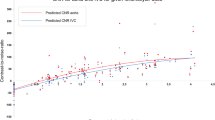Abstract
A prospective double-blind, randomized study was undertaken to compare the diagnostic accuracy of, and patient tolerance to, sodium meglumine ioxaglate 350 (Hexabrix 320) and sodium meglumine ioxaglate 250 (Hexabrix 250) in aortoperipheral arteriopgraphy. There was no significant difference in the incidence or severity of side effects, or radiographic diagnostic quality. Hexabrix 250 is expected to be at least, 20% cheaper, and retains all the advantages of the already available low osmolar contrast media.
Similar content being viewed by others
References
Wolf GL (1986) Safer, more expensive iodinated contrast agents. How do we decide? Radiology 159:557–558
White RI Jr, Halden WJ Jr (1986) Liquid gold: Low-osmolality contrast media. Radiology 159:559–560
Author information
Authors and Affiliations
Rights and permissions
About this article
Cite this article
Joyce, P.F., O'Neill, M., Kweka, E. et al. Comparison of hexabrix 320 and hexabrix 250 in aortoperipheral arteriography: Towards cheaper low osmolar contrast media?. Cardiovasc Intervent Radiol 12, 161–163 (1989). https://doi.org/10.1007/BF02577382
Issue Date:
DOI: https://doi.org/10.1007/BF02577382




